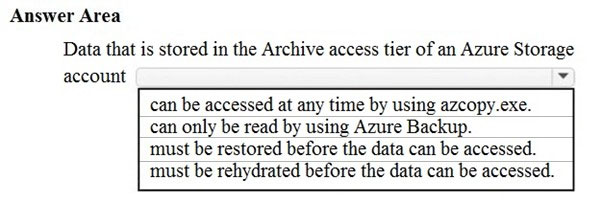AZ-900: Microsoft Azure Fundamentals
This question requires that you evaluate the underlined text to determine if it is correct.
One of the benefits of Azure SQL Data Warehouse is that high availability is built into the platform.
Instructions: Review the underlined text. If it makes the statement correct, select No change is needed. If the statement is incorrect, select the answer choice that makes the statement correct.
No change is needed
automatic scaling
data compression
versioning
Answer is No change is needed
The high availability solution is designed to ensure that committed data is never lost due to failures
Reference:
https://docs.microsoft.com/en-us/azure/sql-database/sql-database-high-availability
To complete the sentence, select the appropriate option in the answer area.

can be accessed at any time by using azcopy.exe.
can only be read by using Azure Backup.
must be restored before the data can be accessed.
must be rehydrated before the data can be accessed.
Answer is must be rehydrated before the data can be accessed.
Azure storage offers different access tiers: hot, cool and archive.
The archive access tier has the lowest storage cost. But it has higher data retrieval costs compared to the hot and cool tiers. Data in the archive tier can take several hours to retrieve.
While a blob is in archive storage, the blob data is offline and can't be read, overwritten, or modified. To read or download a blob in archive, you must first rehydrate it to an online tier.
Example usage scenarios for the archive access tier include:
- Long-term backup, secondary backup, and archival datasets
- Original (raw) data that must be preserved, even after it has been processed into final usable form.
- Compliance and archival data that needs to be stored for a long time and is hardly ever accessed.
Reference:
https://docs.microsoft.com/en-us/azure/storage/blobs/storage-blob-storage-tiers?tabs=azure-portal#archive-access-tier
Your Azure environment contains multiple Azure virtual machines.
You need to ensure that a virtual machine named VM1 is accessible from the Internet over HTTP. Solution: You modify a DDoS protection plan.
Does this meet the goal?
Yes
No
Answer is No.
Match the term to the correct definition. Instructions: To answer, MATCH the appropriate term from the column on the left to its description on the right. Each term may be used once, more than once, or not at all.
| Answer Options | Answer Area | |||
| A | Azure Government | ? | An organization that defines international standarts across all industries. | |
| B | GDPR | ? | An organization that defines standarts used by the United States govenment. | |
| C | ISO | ? | A European policy that regulates data privacy and data protection. | |
| D | NIST | ? | A dedicated public cloud for federal and state agencies in the United States. |
A-B-C-D
B-A-D-C
D-C-B-A
C-D-B-A
B-D-A-C
B-A-C-D
Answer is C-D-B-A
| Answer Options | Answer Area | |||
| A | Azure Government | ISO | An organization that defines international standarts across all industries. | |
| B | GDPR | NIST | An organization that defines standarts used by the United States govenment. | |
| C | ISO | GDPR | A European policy that regulates data privacy and data protection. | |
| D | NIST | Azure Government | A dedicated public cloud for federal and state agencies in the United States. |
You need to ensure that when Azure Active Directory (Azure AD) users connect to Azure AD from the Internet by using an anonymous IP address, the users are prompted automatically to change their password.
Which Azure service should you use?
Azure AD Connect Health
Azure AD Privileged Identity Management
Azure Advanced Threat Protection (ATP)
Azure AD Identity Protection
Answer is Azure AD Identity Protection
References:
https://docs.microsoft.com/en-us/azure/active-directory/identity-protection/howto-sign-in-risk-policy
Your network contains an Active Directory forest. The forest contains 5,000 user accounts.
Your company plans to migrate all network resources to Azure and to decommission the on-premises data center.
You need to recommend a solution to minimize the impact on users after the planned migration.
What should you recommend?
Implement Azure Multi-Factor Authentication (MFA)
Sync all the Active Directory user accounts to Azure Active Directory (Azure AD)
Instruct all users to change their password
Create a guest user account in Azure Active Directory (Azure AD) for each user
Answer is Sync all the Active Directory user accounts to Azure Active Directory (Azure AD)
Which of the following could grant or deny access based on the originating IP address?
Azure Active Directory
Azure Firewall
VPN Gateway
Answer is Azure Firewall. The Azure Firewall grants server access based on the originating IP address of each request. You create firewall rules that specify ranges of IP addresses. Only clients from these granted IP addresses will be allowed to access the server. Firewall rules also include specific network protocol and port information.
Which of the following could require both a password and a security question for full authentication?
Azure Firewall
Application Gateway
Multi-Factor Authentication
Answer is Multi-Factor Authentication (MFA). MFA can require two or more elements for full authentication.
Which of the following services would you use to filter internet traffic in your Azure virtual network?
Azure Firewall
Network Security Group
VPN Gateway
Answer is Network Security Group (NSG). NSGs allow you to filter network traffic to and from Azure resources in an Azure virtual network. An NSG can contain multiple inbound and outbound security rules that enable you to filter traffic to and from resources by source and destination IP address, port, and protocol.
Which of the following lets you store passwords in Azure so you can centrally manage them for your services and applications?
Azure Advanced Threat Protection
Azure Key Vault
Azure Security Center
Answer is Azure Key Vault. Azure Key Vault is a centralized cloud service for storing your applications' secrets. Key Vault helps you control your applications' secrets by keeping them in a single, central location and by providing secure access, permissions control, and access logging capabilities.